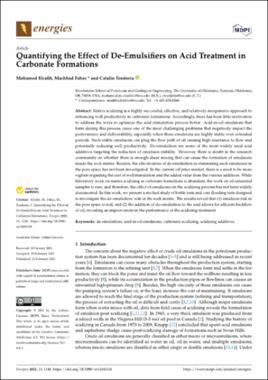| dc.contributor.author | Elsafih, Mohamed | |
| dc.contributor.author | Fahes, Mashhad | |
| dc.contributor.author | Teodoriu, Catalin | |
| dc.date.accessioned | 2021-04-28T19:37:56Z | |
| dc.date.available | 2021-04-28T19:37:56Z | |
| dc.date.issued | 2021-02-21 | |
| dc.identifier.citation | Elsafih M, Fahes M, Teodoriu C. Quantifying the Effect of De-Emulsifiers on Acid Treatment in Carbonate Formations. Energies. 2021; 14(4):1148. https://doi.org/10.3390/en14041148 | en_US |
| dc.identifier.uri | https://hdl.handle.net/11244/329491 | |
| dc.description.abstract | Matrix acidizing is a highly successful, effective, and relatively inexpensive approach to enhancing well productivity in carbonate formations. Accordingly, there has been little motivation to address the ways to optimize the acid stimulation process better. Acid-in-oil emulsions that form during this process cause one of the most challenging problems that negatively impact the performance and deliverability, especially when these emulsions are highly stable over extended periods. Such stable emulsions can plug the flow path of oil causing high resistance to flow and potentially reducing well productivity. De-emulsifiers are some of the most widely used acid additives targeting the reduction of emulsion stability. However, there is doubt in the research community on whether there is enough shear mixing that can cause the formation of emulsions inside the rock matrix. Besides, the effectiveness of de-emulsifiers in eliminating such emulsions in the pore space has not been investigated. In the current oil price market, there is a need to be more vigilant regarding the cost of well stimulation and the added value from the various additives. While laboratory work on matrix acidizing in carbonate formations is abundant, the work on oil-saturated samples is rare, and therefore, the effect of emulsions on the acidizing process has not been widely documented. In this work, we present a stacked study of bottle tests and core flooding tests designed to investigate the de-emulsifiers’ role in the rock matrix. The results reveal that (1) emulsion-risk in the pore space is real, and (2) the addition of de-emulsifiers to the acid allows for efficient backflow of oil, revealing an improvement in the performance of the acidizing treatment. | en_US |
| dc.language | en_US | en_US |
| dc.rights | Attribution 4.0 International | * |
| dc.rights.uri | https://creativecommons.org/licenses/by/4.0/ | * |
| dc.subject | De-emulsifiers | en_US |
| dc.subject | Acid-in-oil emulsions | en_US |
| dc.subject | Carbonate acidizing | en_US |
| dc.subject | Acidizing additives | en_US |
| dc.title | Quantifying the Effect of De-Emulsifiers on Acid Treatment in Carbonate Formations | en_US |
| dc.type | Article | en_US |
| dc.description.peerreview | Yes | en_US |
| dc.identifier.doi | 10.3390/en14041148 | en_US |
| ou.group | Mewbourne College of Earth and Energy::Mewbourne School of Petroleum and Geological Engineering | en_US |

